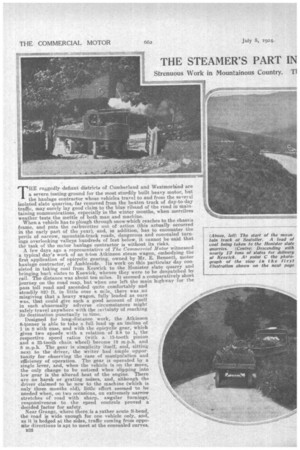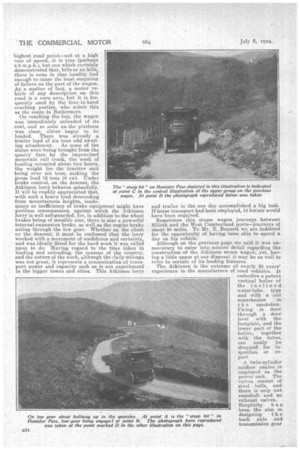THE STEAMER'S PART IN TE QUARRY TRANSPORT.
Page 18

Page 19

Page 20

If you've noticed an error in this article please click here to report it so we can fix it.
Strenuous Work in Mountainous Country. Ti age of a Second Gear Giving a Lower Ratio,
THE ruggedly defiant districts of Cumberland and Westmorland are a severetesting-ground for the most sturdily built heavy motor, but the haulage contractor whose vehicles travel to and from the several isolated slate quarries,-far removed from the beaten track of day-to-day traffic, may surely lay good claim to the blue riband of the road in maintaining communications, especially in the winter months, when merciless weather tests the mettle of both man and machine.
When a vehicle has to plough through snow which reaches to the chassis frame, and puts the carburetter out of action (this actually occurred in the early part of the year), and in addition, has to encounter the perils of narrow, mountain-track roads, dangerous and concealed turnings overlooking valleys hundreds of feet below, it cannot be said that the task of the inctor haulage contractor is without its risks.
A. few days ago a representative of The Commercial Motor witnessed a typical day's work of an 8-ton Atkinson steam wagon, embodying the first application of epicyclic gearing, owned by Mr. E. Bennett, motor haulage contractor, of Ambleside. Its work on this particular day consisted in taking coal from Keswick to the Honister slate quarry and bringing back slates to Keswick, whence they were to be despatched by rail. The distance was about ten miles. It seemed a comparatively short journey on the road map, but when one left the main highway for the pass toll road and ascended quite comfortably and steadily 820 ft. in little over a mile, there was .nd misgiving that a heavy wagon, fully loaded as ours was, that could give such a good account of itself in such abnormally adverse circumstances might safely travel anywhere with the certainty of reaching its destination punctually to time.
Designed for long-distance work, the Atkinson 13-tonner is able to take a full load up an incline of 1.in 8 with ease, and with the epicyclie gear, which gives two speeds with a relation of 2.8 to 1, the respective speed ratios (with a 13-tooth pinion and a 3'3-tooth chain wheel) become 12 m.p.h. and 8 m.p.h. The gear is simplicity itself, and, sitting next to the driver, the writer had ample opportunity for observing the ease of manipulation and efficiency of operation. The gear is operated by a single lever, and, when the vehicle is on the move, the only change to be noticed when slipping into low gear is the altered beat of the engine. There are no harsh or grating noises, and, although the driver claimed to be new to the machine (which is only three months old), little effort seemed to be needed when, on two occasions, on extremely narrow stretches of road with sharp, angular turnings, responsiveness to the speed controls proved a decided factor for safety. Near Grange, where there is a rather acute 8-bend, the road is wide enough for one vehicle only, and, as it is hedged at the sides, traffic coming from opposite directions is apt to meet at the concealed curves.
B32
This happened when the Atkinson and trailer were returning from the slate quarry fully loaded, and the only way out of the irripas8e was for the smaller vehicle—a private car—to back into the entrance to a field to let the Atkinson go by. The incident is merely mentioned in passing, to throw light on some of the road conditions in the district of Keswick.
There is hardly any justification for venturing upon a detailed description of either the power unit or the epicyclic gear of the Atkinson tl-tormer, as both of these have already been dealt with fully in our pages ; but one thing the demonstration of Mr. Bennett's lorry did vindicate, and that was the necessity for a boiler and water tank of such sensible sizes. They are needed in the Lake District. Long gruelling hills with a steady rise make a big demand on the reserve of power, yet, keeping an eye on the pressure gauge, it was noteworthy that with gas-coke as a fuel the needle was very constant at between 190 lb. and the safety point. The day's work began about 6.30 a.m., when the boiler was fired. The wagon had been out in the open all night, the fires having been drawn 14 hr. previously, and in the early-morning hours there had been heavy
it was claimed that usually within three-quarters of an hour there is a steam pressure of 200 lb., but on this occasion, owing to the adverse conditions referred to it took nearly all this time to raise 100 lb.
The load consisted of six tons of coal, to be taken to the Honieter quarry, and this had been loaded up the previous day. On the outward journey we stopped at Derwentwater for a fill of water, loading 150 gallons (threequarters of the tank capacity) in 5 mins. On restarting, only the small drop of 20 lb. was registered by the pressure gauge. Before we had gone much farther, and reached some of the switchback roads between Keswick and Rosthwaite, several short sharp hills with gradients of 1 in 5 or 6 had to be traversed. These provided a useful test of the pulling power of the engine at very low r.p.m The beat was clear and strong—there was no feeling of labouring and straining—and the apex was reached at quite a good turn of speed.
Several small tradesmen's parcels were delivered en route to Seatoller, but, after leaving this village, the really stiff part of the climb commenced along the toll road, which is crossed at intervals with wooden gates. Immediately after leaving the village, the road, which has an exceedingly rough surface, turns upward very sharply on the bend. A voluntary stop was made on the steepest part, and after a short halt although it was doubted whether the wagon could make a clean start,. in point of fact there was no hesitation whatever about it. Then began the climb to Honister Hawse, 1,190 ft. above sea-level, along a narrow, mountain-track road barely wide enough for one vehicle. In the mile and a quarter or so the rise is, as has been stated, over 800 ft., but without apparent effort the engine worked splendidly, and climbed to the B33
highest road point—not at a high -.ate of speed, it is true (perhaps 4-5 m.p.h.), but one which certainly demonstrated that, hills or no hills., there is none in that locality. bad enough to cause the least suspicion of failure on the part of the wagon. As a matter of fact, a motor vehicle of any description on this road is a rara avis, but it is frequently used by the four-in-hand coaching parties, who select this as the route to Buttermcre.
On reaching the top, the wagon was immediately unloaded of its coal, and so soon as the platform was clear, slates began to be loaded. There was already a trailer load of six tons odd awaiting attachment. As some of the slates were being brought from the quarry face by the improvised mountain rail track, the work of loading occupied about two hours, the weight for the tractive unit being over six tons, making the gross load 12 tons 16 cwt. Under brake control, on the descent, the Atkinson lorry behaves splqididly. It will be readily appreciated that, with such a heavy load descending from mountainous heights, inadequacy or inefficiency of brake equipment might have perilous consequences, against which the Atkinson lorry is well safeguarded, for, in addition to the wheel brakes being of sensible size, there is also a powerful internal-expansion brake, as well as the engine brake acting through the low gear. Whether on the climb or the descent, it must be confessed that the lorry worked with a movement of confidence and certainty, and was ideally fitted for the hard work it was called upon to do. Having regard to the time taken in loading and unloading, the contour of the country, and the nature of the work, although the daily mileage was not great, it represents a concentration of transport power and capacity such as is not experienced in the bigger towns and cities. This Atkinson lorry and trailer in the one day accomplished a big task. If horse transport had been employed, 14 horses would have been required.
Sometimes this steam wagon journeys between Silloth and the West Cumberland ports—journeys of about 50 miles. -To Mr. E. Bennett we are indebted for the opportunity of having been able to spend a day on his vehicle.
Although on the previous page we said it was unnecessary to enter into minute detail regarding the construction of the Atkinson steam wagon, yet, having a little space at our disposal it may be as well to refer to certain of its leading features.
The Atkinson is the outcome of nearly 25 years' experience in the manufacture of road vehicles, it .embodies a patent vertical boiler of the inclined water-tube . type and with a coil superheater in t h e smokebox. Firing is done through a door level with the footplate, and the lower part of the boiler, together with the tubes, can easily . be dropped for inspection or repair.
A twin-cylinder uniflow engine is employed as the power --unit. The valves consist of • steel balls, and there is only one camshaft and no exhaust valves.. Simplicity has been the aim in designing t h e back axle and transmission gear






























